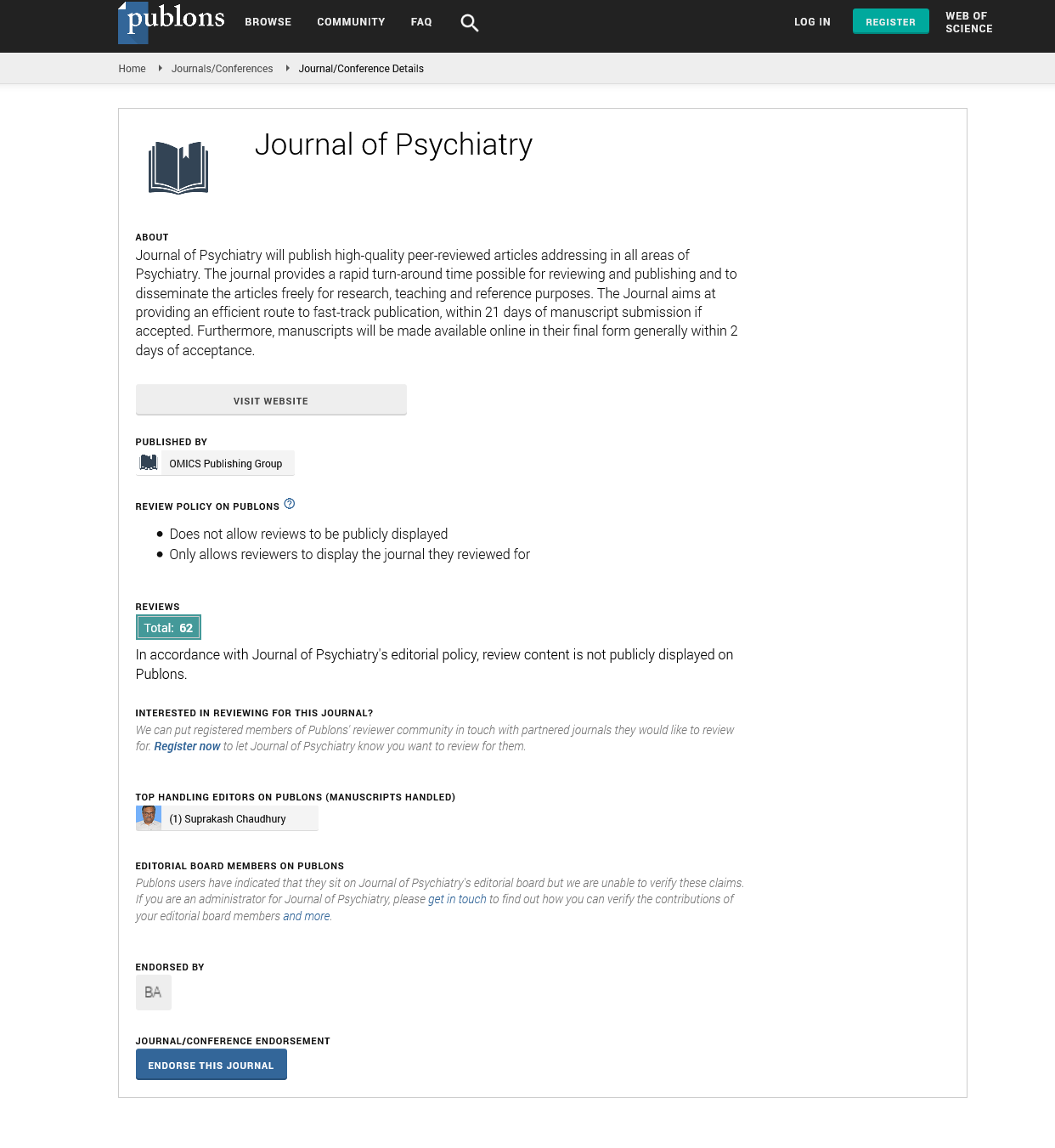Indexed In
- RefSeek
- Hamdard University
- EBSCO A-Z
- OCLC- WorldCat
- SWB online catalog
- Publons
- International committee of medical journals editors (ICMJE)
- Geneva Foundation for Medical Education and Research
Useful Links
Share This Page
Open Access Journals
- Agri and Aquaculture
- Biochemistry
- Bioinformatics & Systems Biology
- Business & Management
- Chemistry
- Clinical Sciences
- Engineering
- Food & Nutrition
- General Science
- Genetics & Molecular Biology
- Immunology & Microbiology
- Medical Sciences
- Neuroscience & Psychology
- Nursing & Health Care
- Pharmaceutical Sciences
Perspective - (2025) Volume 28, Issue 4
Association Between Screen Time and Sleep Disturbances in Adolescents With Attention Concerns
Gianni Lorenzo*Received: 01-Jul-2025, Manuscript No. JOP-25-30179; Editor assigned: 03-Jul-2025, Pre QC No. JOP-25-30179; Reviewed: 17-Jul-2025, QC No. JOP-25-30179; Revised: 23-Jul-2025, Manuscript No. JOP-25-30179; Published: 31-Jul-2025, DOI: 10.35248/2378-5756.25.28.760
Description
The widespread use of digital devices among adolescents has raised growing concerns regarding its impact on sleep especially in those with attention-related difficulties. As mobile phones, tablets and gaming devices become increasingly integrated into daily life, understanding how screen use particularly during evening hours affects sleep quality is essential. For teenagers already experiencing challenges with focus and self-regulation due to attention deficits, the role of screen habits in exacerbating these issues is of particular interest to researchers, clinicians and families alike. This observational study aimed to examine the relationship between evening screen time and sleep patterns in adolescents diagnosed with attention deficit disorders. The research involved a sample of 140 adolescents, aged 13 to 17, all of whom had been clinically diagnosed with attention-related disorders such as Attention-Deficit/Hyperactivity Disorder (ADHD). Over a two-week period, participants recorded their screen use habits and wore sleep-tracking devices to objectively monitor key sleep variables, including total sleep duration time to fall asleep (sleep onset latency) and overall sleep quality.
Each evening, participants logged the duration and type of screen use after 8:00 p.m., including smartphone use, television watching, social media engagement, video gaming and online browsing. Screen time data were cross-referenced with sleep-tracking data from wearable monitors, which captured metrics such as sleep latency, night-time awakenings and total hours slept. In addition, participants completed brief morning check-ins reporting mood, irritability and focus during school-related tasks. The findings revealed a clear and concerning pattern: adolescents who used digital devices for more than two hours after 8:00 p.m. experienced significantly shorter total sleep durations and took longer to fall asleep compared to peers who limited screen use to under one hour. On average, the high screen-time group slept approximately 75 minutes less per night and showed sleep onset delays exceeding 30 minutes beyond those in the low screen-time group.
Notably, adolescents with greater evening screen use also reported higher levels of next-day irritability and diminished concentration during academic activities. These students described feeling foggy, unmotivated, or easily distracted in school settings, which aligns with prior research suggesting that poor sleep quality can impair executive functioning and emotional regulation areas already vulnerable in individuals with attention deficits. Interestingly, the prevalence of screen use in the evening was widespread across the sample suggesting that late-night digital engagement is a normative behavior among adolescents regardless of diagnosis. However, there were important differences observed in outcomes based on evening structure. Participants who reported having structured nightly routines including consistent bedtimes, limited screen access and engagement in offline wind-down activities such as reading or mindfulness demonstrated better sleep continuity and shorter sleep onset latency. These adolescents were also more likely to report feeling alert and focused during the day.
The study's results underscore the strong relationship between digital habits and sleep health, particularly in populations already at risk for attentional and emotional difficulties. While screen use in and of itself is not inherently harmful, its timing and duration appear to play a critical role in sleep outcomes. Blue light emitted from screens is known to suppress melatonin production a hormone crucial for initiating sleep. Moreover, the stimulating nature of digital content ranging from social media notifications to competitive gaming can increase cognitive arousal, making it more difficult for adolescents to transition into restful states. From a clinical perspective, these findings suggest that behavioral interventions aimed at reducing evening screen exposure could serve as a low-cost non-pharmacological strategy to improve sleep outcomes in adolescents with attention deficits. Educating families about the impact of screen use on sleep and attention and supporting the implementation of healthy evening routines could lead to measurable improvements in both sleep quality and daytime functioning.
Schools, mental health providers and pediatricians might also play a proactive role by incorporating sleep hygiene education into support programs for youth with attention difficulties. Simple strategies such as instituting, encouraging device-free bedrooms and promoting offline pre-bedtime activities could collectively contribute to better emotional regulation and academic performance. Despite the compelling findings the study does have limitations. As an observational study, it cannot determine causality meaning it is unclear whether screen use causes poor sleep or whether adolescents who already struggle with sleep are more likely to turn to screens late at night. Additionally, the reliance on self-reported screen time may introduce some bias though this was mitigated by the objective sleep-monitoring data. Future research could benefit from a longer tracking period, inclusion of neurocognitive performance assessments and investigation into the content type to better understand which forms of screen use are most disruptive.
Citation: Lorenzo G (2025). Association Between Screen Time and Sleep Disturbances in Adolescents with Attention Concerns. 28:760.
Copyright: © 2025 Lorenzo G. This is an open-access article distributed under the terms of the Creative Commons Attribution License, which permits unrestricted use, distribution and reproduction in any medium, provided the original author and source are credited.

